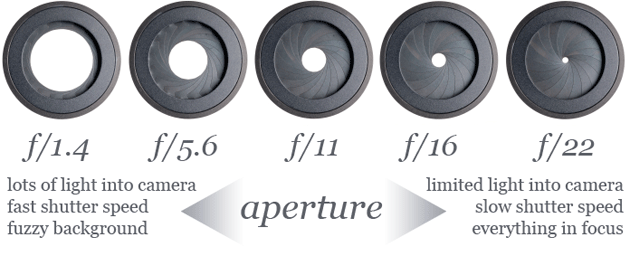
Objects a few feet from the subject will appear just as sharp.į/1.8 and f/22 are extreme examples - there are plenty of apertures in between as well. An aperture of f/22 will let in very little light - but it will also keep most of the scene in focus. With a smaller aperture, the objects further from the subject will come into focus. A portrait taken by focusing on the subject’s eyes at f/1.8 will have the subject’s nose - and maybe even the tips of their eyelashes - out of focus.Īs the lens aperture shrinks, the range of distances that will produce a sharp image gets wider. A very wide aperture, like f/1.8, produces an image with a very narrow depth of field where even objects that are an inch away are a bit fuzzy. A larger opening in the lens creates a brighter image and vice versa.īut as the lens’s aperture or opening gets wider, the distance that produces a sharp object gets shorter. As one of three different exposure settings, aperture influences how much light comes into an image by changing the size of the opening in the lens. Depth of field influences the foreground, or the front of the image, just as much as the background.Īperture allows the photographer to control just how large (or small) that range of distance is. If you are taking an image of three objects at three different distances - like a group photo with three rows, for example - focusing on the middle object will help you use that entire range of focus. Of course, one inch and several feet are just examples - the exact range varies, but short ranges are called narrow and long ranges are referred to as a wide depth of field.ĭepth of field also goes both ways - if an object that is six inches behind the subject is in focus, an object six inches in front of the subject will also be in focus.

With a wide depth of field, even objects several feet from the subject would still be sharp. In images with that narrow range, the background appears very out of focus.Ī wide depth of field, on the other hand, means that range is wide. For example, a shallow depth of field could mean objects that are farther than an inch from the subject are blurred. But, if you take that camera setting to the other extreme, objects an inch away from the subject will appear blurred.Ī shallow depth of field means that range of distance where objects appear to be sharp is very small. For example, with certain camera settings (which we’ll talk about next), objects a foot or even several feet away from the subject will still remain acceptably sharp. A wide angle lens captures a wider field of view, but fails to capture much detail.īut what about the other objects in the image? Since those items are at a different distance from the camera than the subject, the light rays won’t meet together at the sensor, which means those objects are out of focus.īut how far away do those other objects need to be in order to be out of focus? Will an object a foot away be in focus? What about an inch? A millimeter?ĭepth of field determines the range of distance where objects will remain sharp. Any lens with a shallow focal length could be considered a wide angle lens. A camera lens with a longer focal length will result in a narrow angle of view, with the focal point of the image being farther in the distance. Those different glass pieces inside the lens adjust so that the light bouncing off your subject meet at the sensor, creating an in-focus image.

The points of light that meet before - or after - the image sensor are out of focus.įocus is dependent on distance. When the points of light meet at the sensor, the image is in focus. The different pieces of glass inside the lens adjust the light rays so that they come together at the image sensor.

A lens redirects light to the camera’s sensor. Understanding depth of field (DOF) is a bit simpler once you understand a bit of how a camera - and a camera lens - works.


 0 kommentar(er)
0 kommentar(er)
